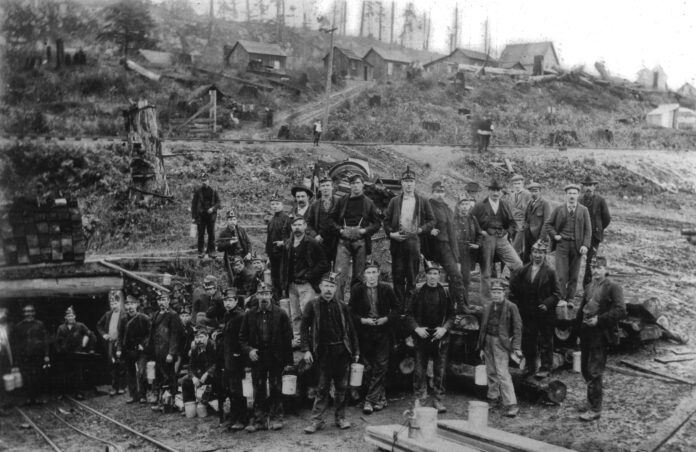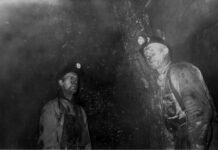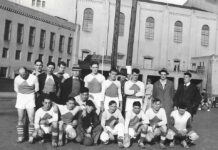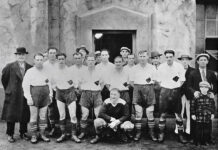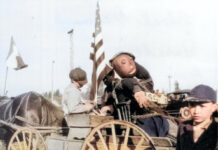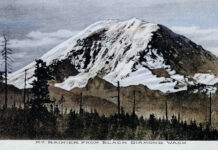In Black Diamond today, Lawson is generally known as the name of two streets plus the hill that overlooks them. When this photo was taken, circa 1900, Lawson was its own coal mining town founded by a Kentucky-born businessman named Eugene Lawson who arrived in Seattle a week before the Great Fire of 1889. The Lawson mine was sandwiched between and competing with three mines operated by the Black Diamond Coal Mining Company and several more in Franklin owned by Pacific Coast Coal Company.
Eugene Lawson started business as a freight forwarder, to use a modern expression. Over 130 years ago, that meant operating carts pulled by teams of horses to move coal and other goods from the rail yards to shipping wharves. Lawson’s business prospered and he soon built bunkers to store coal where connections with the Black Diamond and Franklin coal producers were probably formed. Like many an entrepreneur, Lawson saw profits in coal and by 1895 opened a mine east of Black Diamond that was initially called the Light Ash Mine.
Mining the same seam of McKay coal that made Black Diamond and Franklin famous, the Light Ash Mine prospered despite the highly flammable methane gas that mining released. Within a year, Lawson’s Light Ash Mine employed 28 miners, 24 of whom worked underground with four on the surface, producing 11,000 tons that first year. Houses were built by the Germans and Austrians who predominated the workforce.
Coal production quadrupled by 1898, as employment grew to 48 men. By May 1899, Lawson sold his mine and town to Pacific Coast Coal whose operations in Newcastle, Coal Creek, and Franklin made it Washington’s second-biggest coal producer behind the Roslyn mines owned by the Northwestern Improvement Company. Pacific Coast poured fresh money into Lawson and sank two new slope entries, plus modern surface facilities featuring the latest machinery to handle and store coal. More than $175,000 ($6.6 million in 2024 dollars) was spent on mine renovations with another $50,000 ($1.9 million in 2024 dollars) to build 52 cottages, new water and sewage systems, a store, doctor’s office, butcher shop, and schoolhouse.
New Lawson was born on a hill above Black Diamond that still bears his name. Pacific Coast immediately increased production to 400 tons per day, and by 1901 the workforce tripled to 179 miners while annual production doubled to 97,000 tons. But tragedy struck on October 1, 1902 at 8:30 pm, when an explosion of the 4th level south claimed 11 lives while four miners were injured. The explosion’s cause was believed to be the second of two dynamite shots – the first releasing methane gas and coal dust, the second igniting the gas and dust.
But life in a small town goes on. Homes need heat, customers demand fuel, miners need jobs, and orders require fulfillment. The Lawson mine continued averaging 85,000 tons annually, about 12% of Pacific Coast’s output. Then came the bloody Sunday morning of Nov. 6, 1910, when 11 miners were being lowered down the slope while five men waited at the bottom of the mine to end their graveyard shift. An explosion ripped through the underground workings so powerful that it completely wrecked the mine as surface facilities caved into the ruins. All 16 men perished with bodies of the five men at the bottom not capable of being reached. The cause of the explosion was never fully explained though several theories were advanced.
Four days later, the miners’ last rites were performed at the Catholic Church with the services held under the auspices of the United Mine Workers. A funeral procession slowly marched to the Black Diamond Cemetery. A crowd estimated at 1,500 people paid their respects to the memory of the fallen miners. Eight bodies were interred in one grave, while three others were buried elsewhere. The five unrecovered miners will forever lie beneath Lawson Hill, under 2,000 feet of cover and 800 feet below sea level.
Photo enhancements were provided by Boomer Burnham doing business as: http://www.boomersphotography.com/ This photo featuring a group of miners standing outside the Old Lawson mine just below the railroad tracks between Black Diamond and Franklin comes courtesy of the Black Diamond History Museum. The original mine was located approximately at 26000 Old Lawson Road. Next week, more about Eugene Lawson and his interesting life

